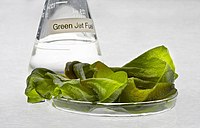
Photo from wikipedia
The aim of this study was to investigate the cultivation of Nostoc sp., Arthrospira platensis and Porphyridium purpureum in industrial wastewater to produce phycobiliproteins. Initially, light intensity and growth medium… Click to show full abstract
The aim of this study was to investigate the cultivation of Nostoc sp., Arthrospira platensis and Porphyridium purpureum in industrial wastewater to produce phycobiliproteins. Initially, light intensity and growth medium composition were optimized, indicating that light conditions influenced the phycobiliproteins production more than the medium composition. Conditions were then selected, according to biomass growth, nutrients removal and phycobiliproteins production, to cultivate these microalgae in food-industry wastewater. The three species could efficiently remove up to 98%, 94% and 100% of COD, inorganic nitrogen and PO43--P, respectively. Phycocyanin, allophycocyanin and phycoerythrin were successfully extracted from the biomass reaching concentrations up to 103, 57 and 30 mg/g dry weight, respectively. Results highlight the potential use of microalgae for industrial wastewater treatment and related high-value phycobiliproteins recovery.
Journal Title: Bioresource technology
Year Published: 2020
Link to full text (if available)
Share on Social Media: Sign Up to like & get
recommendations!